| 1 | Perhaps the highest Indian bite rate |
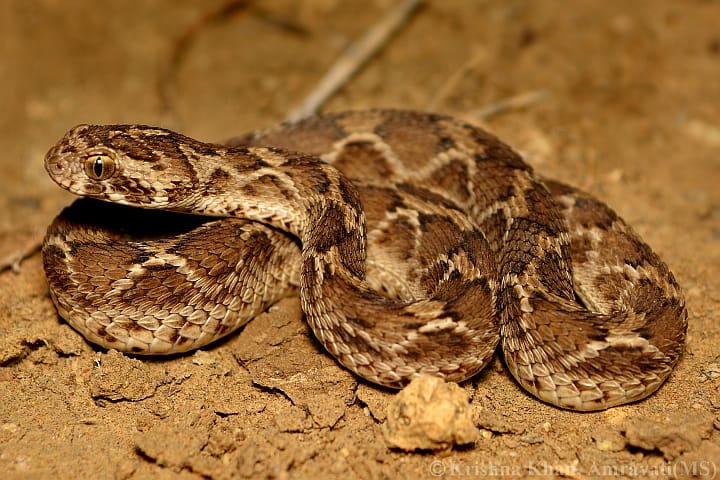
In India, four snakes are feared above all. The Indian cobra, Indian krait, and Russell’s vipers are three horrors, killing thousands each per year, and the final member is the saw-scaled viper. Compared to the rest, this stereotypical-looking viper prefers the drier regions with baked soils and constant sun. Russell’s vipers commonly pop up in rice paddies and farmland, but saw-scaled vipers almost never venture into bushy agriculture.
Instead, you’ll find them in deserts, semi-deserts, dry scrublands, and rocky open fields. In Sinhalese, this species is called “vali polonga”, meaning sand snake. Saw-scaled vipers are best adapted for slithering over sand, and struggle on hard flat surfaces. During the day, they hide beneath rocks, or in mammal burrows which they purposefully enlarge. They’re averse to heavy rains, and will climb vegetation the moment they sense the heavens opening.
Saw-scaled vipers are an inflexible snake, and never appear in humid rainforests. However, in the dry zones they do appear in, they can be extremely common, with a fresh viper round every corner. Scientist never struggle to track them down for their studies. Saw-scaled vipers occupy the whole of India, and stretch to Iraq in the west, and Bangladesh in the east.
| 2 | Desert adaptions |
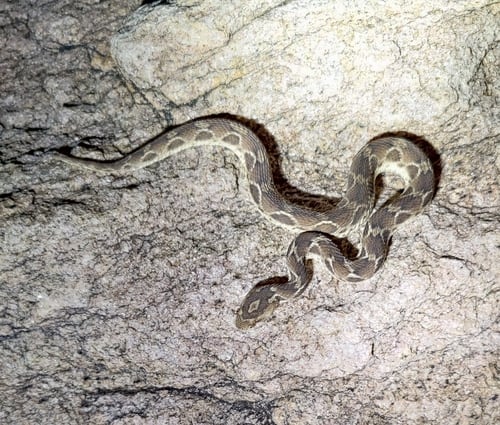
Saw-scaled vipers get their name from a unique noise they produce when threatened. The species coils itself into a tight 8-shape, then grinds together its sharply keeled body scales. Instead of backwards pointing, these scales angle upwards, and the rhythmical grinding produces a saw-like rasp, like a pot of boiling water. It’s believed that this trick evolved to replace hissing, which would cause higher moisture loss in the body dry deserts they call home.
This is also one of the few species worldwide to use sidewinding. On a pavement, saw-scaled vipers are slow and clumsy, but on the loose desert sands, they transform into an agile ninja. Like a sidewinder rattlesnake, they move sideways with just two small points of their body touching the ground, to avoid the searing heat. They can move disturbingly quickly, and another trick is making small jumps across the sand occasionally, minimising contact further. When threatened, saw-scaled vipers also writhe their body unceasingly, so that there’s never a fixed target for a potential predator.
| 3 | A scorpion-based diet |
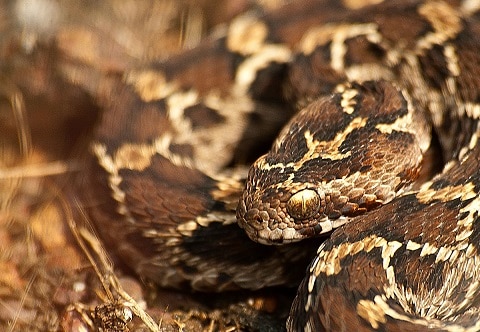
The saw-scaled viper’s stomach and taste buds have adapted to cope with desert environments. Consequently, this species gets a large chunk of its calories from arthropods and scorpions. The Echis family has 13 members, and when Echis carinatus was compared to 3 others, it was the most arthropod-loving of all, making up 65% of its calories, with 35% being vertebrates.
Even the saw-scaled viper’s venom is specially attuned towards killing scorpions. Relatives such as the painted and African saw scaled vipers were weaker, and were clearly more targeted against rodents instead. The Egyptian saw-scaled viper (Echis pyramidum) was the only other member with this scorpion obsession.
Saw-scaled vipers eat mammals and reptiles as well, with one confirmed prey being the snake-eyed lizard (Ophisops elegans), as well as short-fingered geckos (Stenodactylus family). Its hunting strategy is to inject venom into its prey, then release rather than holding on, before stalking them through the sand using chemosensing. Saw-scaled vipers aren’t ultra disciplined, as they’ll sometimes go nuts and bite 7 lizards before remembering to eat the first one.
| 4 | Venom toxin profile |
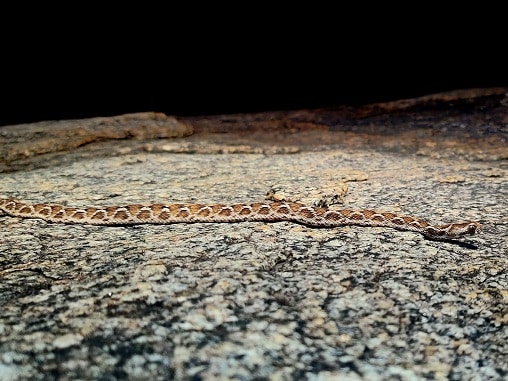
Saw-scaled viper venom has very few neurotoxins, and instead specialises in rapid destruction of tissues. It contains cytotoxins which not only shred the skin, but penetrate deeply and cause necrosis in the muscle tissue below.
It’s also a hemotoxic venom which causes spontaneous, uncontrollable bleeding in victims, reducing the ability of blood to clot. Worse is what’s happening to blood inside the body. The venom causes hemolysis, when red blood cells rupture and release their cytoplasmic contents. This causes havoc with the kidneys, and kidney failure is the most common cause of death with saw-scaled vipers (unlike the Indian cobra, which focusses on the lungs).
Saw-scaled vipers also have a particularly painful bite, like their Russell’s viper neighbour. Their bite can produce swelling within minutes, and in some victims, the entire bitten limb swells up like a balloon, which takes 12-24 hours to kick in. Painful blisters also erupt on the skin surface. Without antivenom, the mortality rate is estimated at 20%, but the good news is that hospitals all over India are now stocked with an undepletable armoury of the stuff. Consequently, deaths from saw-scaled vipers are very rare these days.
| 5 | Survivable, just |
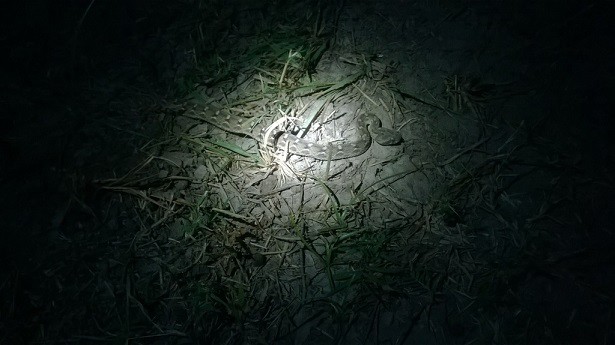
Within the big 4, the Russell’s viper is severely deadly, while the saw-scaled viper causes the most bites in India annually. For example, a study examined the Maharashtra region of mid-west India. 663 snakebites were recorded at one small hospital from 1992 to 2001, of which the saw-scaled viper was easily the most common with 274 cases. However, only 8 (2.9%) of those patients were transferred to a larger hospital. Meanwhile, Russell’s vipers caused 40 snakebites, and 20 victims (50%) were transferred. The Indian cobra caused 71 bites, with 14.1% upgraded to larger hospitals, and the Indian krait caused 42 bites with 19% transferred.
Saw-scaled vipers were also the least toxic of the four by death rate. The Indian cobra was the deadliest, with 18.7% of victims dying. However, saw-scaled vipers bite their victims throughout the year, while Indian cobras favoured March, April and May.
In some areas of India, the saw-scaled viper causes 80% of venomous snakebites. The same is true for Iran, where it’s the deadliest snake in the 13 southeastern provinces where it’s found. Given that over 1.2 million Indians died from snakebite from 2000-2019, the saw-scaled viper might have one of the highest bite totals of any snake worldwide (though not necessarily deaths).
| 6 | Know the danger scenarios |
Saw-scaled vipers aren’t home invaders. Instead, the majority of bites happen when barefoot victims step on them at night, or while wearing flimsy sandals. Many Indians are bitten while cutting grass by hand with scythes. The top locations for bites are the fingers, feet and toes.
It’s their nocturnal habits which make them so treacherous, as people stumble onto them as they rest during daytime. Saw-scaled vipers also have fantastic camouflage, with no neon blotches, just the usual subtle viper shades.
The exact toxicity of saw-scaled viper venom is still being debated. One estimate is 0.24mg, which beats the Russell’s viper (0.4mg), but another estimate puts them as weak as 6.65mg. What’s undeniable is that their venom yield is far lower: 5-48mg, versus up to 250m for the Russell’s viper. The record venom yield for Echis carinatus was just 72mg. In the US, the cottonmouth has a yield per bite of 80-170mg.
While saw-scaled vipers prefer to flee from threats, they can be extremely aggressive when backed into a corner. Once they shift into attack mode, saw-scaled vipers will lunge forward like a jack-in-the-box at the slightest provocation.
| 7 | Hides in dry plant matter |
The saw-scaled viper is a small species, with adults averaging at 30cm. A study from Iraq found that the maximum Echis carinatus observed was just 50cm. However, those from Rajasthan in northwest India grow to be significantly longer, sometimes 80cm. This is a separate subspecies, called Echis carinatus sochureki, with those in southern India being E. c. carinatus.
Sri Lanka is also home to its own subspecies: E. c. sinhaleyus. These are shorter again, as a study from Jaffna found them to average at 260mm, while their fangs were 3-5mm. Overall, India has only two of the 5 subspecies; the others live in Sri Lanka, Pakistan, and Uzbekistan.
One study examined the Jaffna peninsula of northern Sri Lanka, a dry, war-torn place with an abundance of mango and coconut plantations. Of 217 venomous snakebites in 2009, 99 (45.6%) came from saw-scaled vipers, making it overwhelmingly the bitiest species in the region. One group was badly affected: those living in poorly constructed houses surrounded by sandy soils, or shrubland, with piles of dry coconut husks lying nearby, which the saw-scaled vipers often took refuge in.
| 8 | Contains antidepressants? |
The saw-scaled viper’s venom is a corrosive soup of destruction, but being so complex, scientists have extracted many possible drugs from it. One is echistatin, which is now used as an anti-coagulant medication, turning evil to good. The advantage is that compared to other promising snake toxins, echistatin has an extremely simple structure, making it easy to synthesise in a laboratory.
But a particularly interesting study from 2006 isolated a possible antidepressant. Rather than intact venom, this was a photooxisied version, saw-scaled viper toxins degraded by being exposed to intense ultraviolet light. It was given to rats, who then faced a series of challenges, as were a group of placebo rats. The SSV venom rats took less time to escape a water maze, and were immobile for less time when initially placed in the water maze. Meanwhile, some mice were given pentobarbitone, a barbiturate sedative commonly used in studies to test antidepressants against. The mice given the venom product spent less time in pentobarbitone hypnosis than the other mice.
Added together, the results led scientists to conclude that the photooxised venom had promise against treatment-resistant depression patients. The next step would probably be to isolate the specific compounds involved.
| 9 | A traditional remedy proven to work |
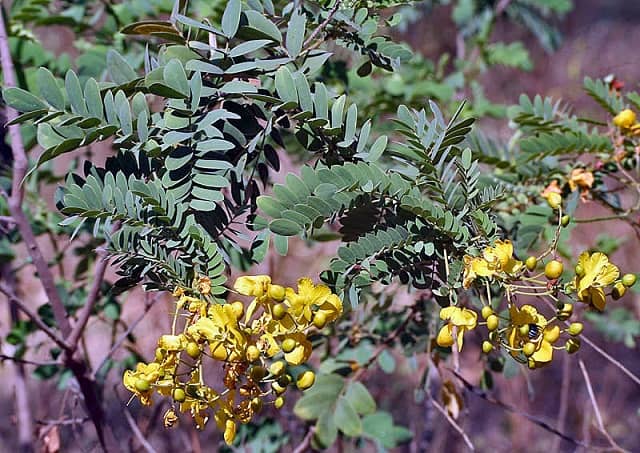
Antivenom was invented for saw-scaled vipers in the 20th century, but Indian healers weren’t waiting around idly for thousands of years. For years, village elders have been crushing and applying the leaves of Senna auriculata to victims of snake and scorpion bites. This is a shrub with yellow flowers, which is mostly found in the dry regions of India and Sri Lanka. It can tolerate weeks without moisture, but dies off rapidly in the cold. Its other traditional uses include treating conjunctivis and diabetes, and in 2014, scientists decided to test Senna auriculata leaves on mice, deliberately given a saw-scaled viper bite. Was the remedy really ancient wisdom, or just a piece of folklore nonsense?
The answer was clear. When applied to the bite wound, it inhabited proteinases and hyaluronidases, which cause local damage to tissues. When swallowed, the flower extract was beneficial against haemorrhaging, swelling, and myotoxicity (muscle damage).
Overall, the old plant remedy increased the survival of mice nearly 6 fold, at 17 hours vs 3 hours. Antivenom is always safer, but the saw-scaled viper really does have a miracle plant waiting out there in the wilderness.
| 10 | The conclusive ID sign |
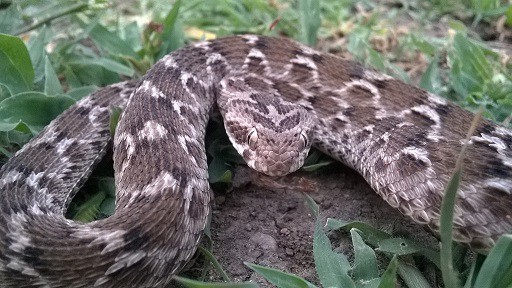
A classic way to identify the saw-scaled viper is a cross-shaped marking on its head. This could also look like the underside of a bird or jumbo jet. Elsewhere, they have classic viper markings, with beige and black interlocking stripes with white markings intermixed.
Their belly is far different, white with many small black spots. Saw-scaled vipers also have a faint black line connecting the eye to corner of mouth. They have a thick head, a short neck, and vertical pupils. It’s believed that Indian egg-eating snakes and the gecko Teratolepis fasciata are mimicking this desert viper’s patterns.
Baby saw-scaled vipers are born from April to August, and are about the length of a pencil, just 11-15cm. Echis carinatus lays live young rather than eggs, usually 3-15, The maximum ever recorded was 23 newborns. The babies are independent instantly, with no motherly care, and are vulnerable to being picked up by birds or lizards on the bare desert floor. Those who get the hang of hiding beneath rocks quickly are more likely to survive.